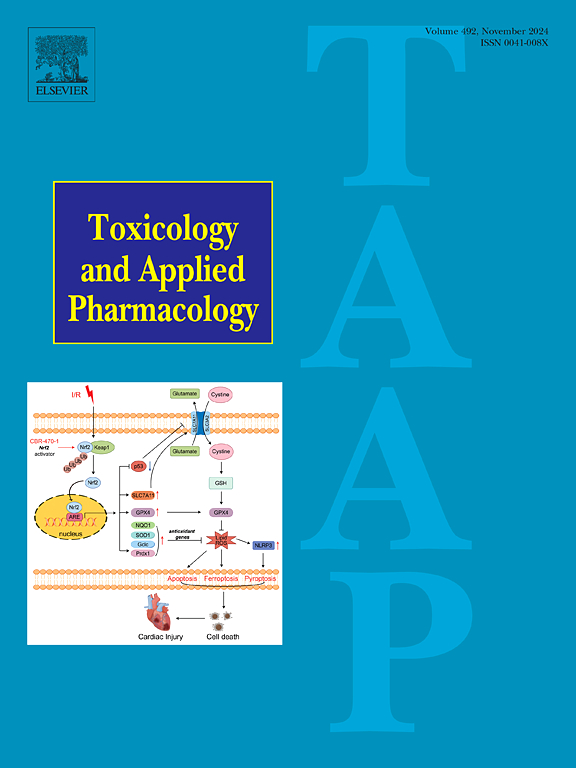肝细胞线粒体DNA通过Stim1/ orai1诱导的三氯乙烯致敏小鼠足细胞损伤激活储存操作的Ca2+进入:肝脏和肾脏串扰的新见解。
IF 3.3
3区 医学
Q2 PHARMACOLOGY & PHARMACY
引用次数: 0
摘要
以往的临床病例研究显示,三氯乙烯(OMDT)引起的职业性药物样皮炎患者严重肝损害常并发肾损害。然而,这种串音的机制尚不清楚。在这项研究中,我们从tce致敏阳性小鼠中提取肝细胞mtDNA,并将其与小鼠足细胞系MPC5共处理。在肝细胞mtDNA预处理的MPC5细胞中,基质相互作用分子1 (Stim1)和钙释放激活钙通道蛋白1 (Orai1)蛋白的表达无论是否干扰干扰素刺激因子基因(STING)蛋白均无显著变化。随后,分别对Stim1和Orai1进行siRNA干扰处理,发现可显著改善足细胞损伤。此外,通过慢病毒转染使关键蛋白Orai1过表达,炎症因子的表达明显升高。动物实验中,采用SOCE抑制剂YM-58483治疗tce致敏小鼠,YM-58483可减轻足细胞损伤蛋白表达的降低。综上所述,本研究探讨了肝细胞mtdna介导的足细胞损伤在TCE致敏阳性小鼠Ca2+信号通路激活和免疫肾损伤中的作用。我们发现肝细胞mtDNA通过增加Orai1和Stim1之间的相互作用来增强SOCE,并且肝细胞mtDNA加工介导的SOCE激活调节足细胞分泌炎症因子。SOCE抑制剂逆转了这一现象,减轻了TCE致敏引起的免疫肾损伤。本研究为TCE致敏引起肝脏肾损伤和肾串扰的机制提供了新的认识。本文章由计算机程序翻译,如有差异,请以英文原文为准。

Hepatocyte mitochondrial DNA activated store-operated Ca2+ entry via Stim1/Orai1-induced podocyte injury in trichloroethylene sensitized mice: A new insight in liver and kidney crosstalk
Previous clinical case studies revealed that patients with severe liver damage often develop kidney damage in occupational medicamentose-like dermatitis due to trichloroethylene (OMDT). However, the mechanism of this crosstalk is unknown. In this study, we extracted hepatocyte mtDNA from TCE-sensitized positive mice and co-treated it with a mouse podocyte line, MPC5. The expression of the stromal interaction molecule 1 (Stim1) and calcium release-activated calcium channel protein 1 (Orai1) proteins did not change significantly with or without interference with the Stimulator of interferon gene (STING) protein in hepatocyte mtDNA pretreated MPC5 cells. Subsequently, siRNA interference treatment of Stim1 and Orai1, respectively, was found to significantly ameliorate the damage to podocytes. Moreover, lentiviral transfection for overexpression of the key protein Orai1 was carried out, and the expression of inflammatory factors was significantly elevated. In animal experiments, the SOCE inhibitor YM-58483 was used to treat TCE-sensitized mice, and the administration of YM-58483 alleviated the reduction in the expression of podocyte injury proteins. In summary, this study explored the role of hepatocyte mtDNA-mediated podocyte injury in Ca2+ signaling pathway activation and immune kidney injury in TCE sensitization-positive mice. We found that hepatocyte mtDNA enhances SOCE by increasing the interaction between Orai1 and Stim1 and that SOCE activation mediated by hepatocyte mtDNA processing regulates the secretion of inflammatory factors by podocytes. SOCE inhibitors reversed this phenomenon and mitigated immune kidney damage caused by TCE sensitization. This study provides new insight into the mechanisms of renal damage in liver and kidney crosstalk induced by TCE sensitization.
求助全文
通过发布文献求助,成功后即可免费获取论文全文。
去求助
来源期刊
CiteScore
6.80
自引率
2.60%
发文量
309
审稿时长
32 days
期刊介绍:
Toxicology and Applied Pharmacology publishes original scientific research of relevance to animals or humans pertaining to the action of chemicals, drugs, or chemically-defined natural products.
Regular articles address mechanistic approaches to physiological, pharmacologic, biochemical, cellular, or molecular understanding of toxicologic/pathologic lesions and to methods used to describe these responses. Safety Science articles address outstanding state-of-the-art preclinical and human translational characterization of drug and chemical safety employing cutting-edge science. Highly significant Regulatory Safety Science articles will also be considered in this category. Papers concerned with alternatives to the use of experimental animals are encouraged.
Short articles report on high impact studies of broad interest to readers of TAAP that would benefit from rapid publication. These articles should contain no more than a combined total of four figures and tables. Authors should include in their cover letter the justification for consideration of their manuscript as a short article.

 求助内容:
求助内容: 应助结果提醒方式:
应助结果提醒方式:


